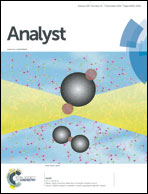Rapid, highly sensitive detection of herpes simplex virus-1 using multiple antigenic peptide-coated superparamagnetic beads†
Abstract
A sensitive, rapid, and label free magnetic bead aggregation (MBA) assay has been developed that employs superparamagnetic (SPM) beads to capture, purify, and detect model proteins and the herpes simplex virus (HSV). The MBA assay is based on monitoring the aggregation state of a population of SPM beads using light scattering of individual aggregates. A biotin–streptavidin MBA assay had a femtomolar (fM) level sensitivity for analysis times less than 10 minutes, but the response of the assay becomes nonlinear at high analyte concentrations. A MBA assay for the detection of HSV-1 based on a novel peptide probe resulted in the selective detection of the virus at concentrations as low as 200 viral particles (vp) per mL in less than 30 min. We define the parameters that determine the sensitivity and response of the MBA assay, and the mechanism of enhanced sensitivity of the assay for HSV. The speed, relatively low cost, and ease of application of the MBA assay promise to make it useful for the identification of viral load in resource-limited and point-of-care settings where molecular diagnostics cannot be easily implemented.


 Please wait while we load your content...
Please wait while we load your content...